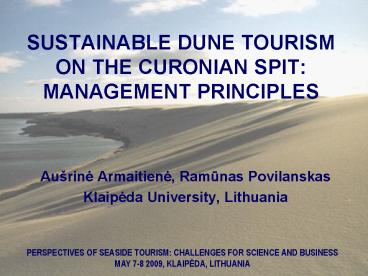SUSTAINABLE DUNE TOURISM ON THE CURONIAN SPIT: MANAGEMENT PRINCIPLES PowerPoint PPT Presentation
1 / 12
Title: SUSTAINABLE DUNE TOURISM ON THE CURONIAN SPIT: MANAGEMENT PRINCIPLES
1
SUSTAINABLE DUNE TOURISM ON THE CURONIAN
SPITMANAGEMENT PRINCIPLES
- Aurine Armaitiene, Ramunas Povilanskas
- Klaipeda University, Lithuania
PERSPECTIVES OF SEASIDE TOURISM CHALLENGES FOR
SCIENCE AND BUSINESS MAY 7-8 2009, KLAIPEDA,
LITHUANIA
2
Contents
- Introduction
- Approach
- The study area
- Results
- Conclusions
PERSPECTIVES OF SEASIDE TOURISM CHALLENGES FOR
SCIENCE AND BUSINESS MAY 7-8 2009, KLAIPEDA,
LITHUANIA
3
Introduction
- The main attention in the environmental
management in recent decades is paid to the
identification and assessment of the essential
principles of the sustainable development - The necessity to identify and follow the
principles of sustainable development is the key
prerequisite of the integrated coastal management - It is self-evident that management is basically
integrated where plans, programmes and measures
are thought of in such a way as to optimize
sustainable development
PERSPECTIVES OF SEASIDE TOURISM CHALLENGES FOR
SCIENCE AND BUSINESS MAY 7-8 2009, KLAIPEDA,
LITHUANIA
4
Introduction
- According to A. Vallega (1999), this implies the
content of management in terms of resource use
patterns, organization of decision making
centres, protection and conservation of the
environment and cultural heritage, social
participation, and other being designed in such
a way as to optimize efforts to pursue
sustainable development - In short, coastal management is integrated where
its specific goals are strictly correlated with
the pursuit of the integrity of the ecosystem,
economic efficiency and social equity
PERSPECTIVES OF SEASIDE TOURISM CHALLENGES FOR
SCIENCE AND BUSINESS MAY 7-8 2009, KLAIPEDA,
LITHUANIA
5
Approach
- The emergence of principles of the integrated
coastal management result largely from the major
change in the cultural and cognitive paradigm of
nature, i.e., the shift from the
anthropocentric to biocentric ordering of the
nature. - The evolution of cultural concepts of the
European dune landscapes is the best example of
such a shift from alien and evil force to be
overcome to almost sacred, positive landscape
with outstanding cognitive and ecological values - Besides other ecological and aesthetic values,
shifting dunes became appreciated as a valuable
tourism resource in recent decades
PERSPECTIVES OF SEASIDE TOURISM CHALLENGES FOR
SCIENCE AND BUSINESS MAY 7-8 2009, KLAIPEDA,
LITHUANIA
6
The study area
- The varied and a very dynamic landscape with high
biological diversity is a distinctive feature of
the Curonian Spit on a regional scale - The 33-km long ridge of 4060 m high shifting
Curonian dunes is the second-longest coastal
ridge of shifting dunes in Europe - It is protected as a cross-border strict nature
reserve within the Kurshskaya kosa national park
on the Russian side of the spit and Kuriu nerija
national park on the Lithuanian side.
PERSPECTIVES OF SEASIDE TOURISM CHALLENGES FOR
SCIENCE AND BUSINESS MAY 7-8 2009, KLAIPEDA,
LITHUANIA
7
The study area
Due to its unique blend of nature and culture
values, the whole Curonian Spit was in 2000
included into the UNESCO World Heritage List as a
single cross-border cultural landscape of
shifting and forested dunes of outstanding
international importance, which is under constant
threat from natural forces
PERSPECTIVES OF SEASIDE TOURISM CHALLENGES FOR
SCIENCE AND BUSINESS MAY 7-8 2009, KLAIPEDA,
LITHUANIA
8
The study area
PERSPECTIVES OF SEASIDE TOURISM CHALLENGES FOR
SCIENCE AND BUSINESS MAY 7-8 2009, KLAIPEDA,
LITHUANIA
9
Results
- Our investigations reveal that even the slightest
invasion of recreation facilities into the
shifting dunes of the Curonian Spit disturbs
smooth flows of energy and matter and of the
biotic information within the strip seascapes of
the shifting dunes - Thus, the invasion of recreation facilities into
the shifting dunes is one of the critical agents
(integrity thresholds) for the robust sustainable
development of the shifting dune seascapes
PERSPECTIVES OF SEASIDE TOURISM CHALLENGES FOR
SCIENCE AND BUSINESS MAY 7-8 2009, KLAIPEDA,
LITHUANIA
10
Conclusions
- It is necessary to change functional zoning
principles of the Curonian Spit and draw the
functional zones according to the gradient
boundaries of the strip seascapes (i.e., along
the longitudinal axes of the strip seascapes of
the Curonian Spit instead of the current
functional divides along the perpendicular axes) - As a consequent result of such changes should be
a radical change towards regulation of the dune
tourism on the Curonian Spit
PERSPECTIVES OF SEASIDE TOURISM CHALLENGES FOR
SCIENCE AND BUSINESS MAY 7-8 2009, KLAIPEDA,
LITHUANIA
11
Conclusions
- It is necessary to abolish any restrictions for
tourists to enter and travel across the sandy
plain (palve) of the Curonian Spit freely within
the strict nature reserves combining their
itineraries with limited and regulated
possibilities to ascend and enjoy the highest
shifting dunes of the Curonian dune ridge - Tourist flows on palve will control the
proliferation of the forest and brushwood and
enhance the supply of sand from the palve to the
shifting dunes
PERSPECTIVES OF SEASIDE TOURISM CHALLENGES FOR
SCIENCE AND BUSINESS MAY 7-8 2009, KLAIPEDA,
LITHUANIA
12
Thank you for your attention!

